ASEAN
ASEAN
ASEAN (Association of South East Asian Nations)
For UPSC IAS exam preparation, understanding ASEAN (Association of Southeast Asian Nations) is crucial, particularly for International Relations, as it’s a significant regional organization with economic and strategic importance, especially in the context of India’s “Act East” policy.
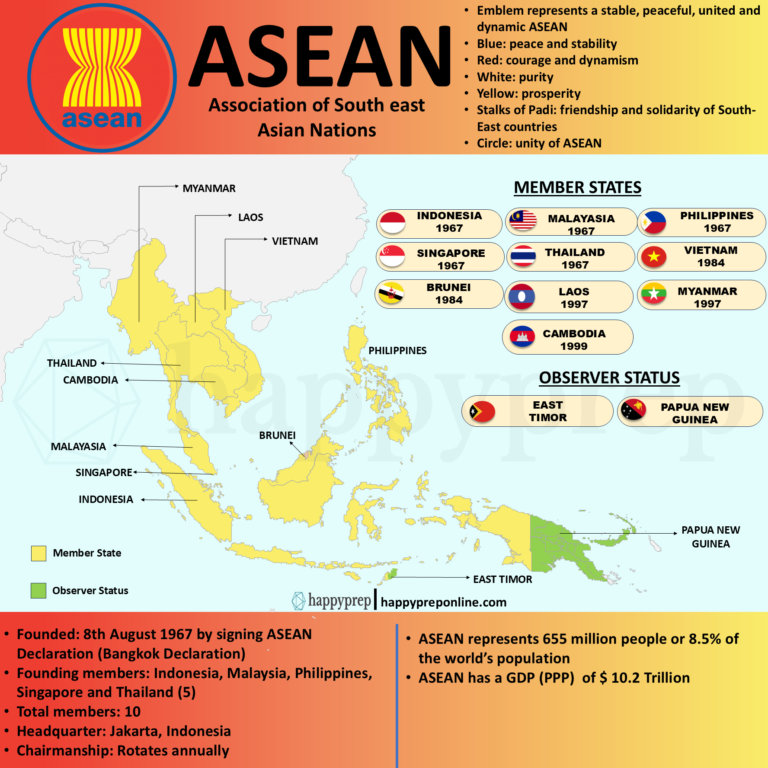
Origin
- The Association of Southeast Asian Nations (ASEAN) was born by the signing of the ASEAN Declaration which is also called Bangkok Declaration.
- Foreign Ministers of Indonesia, Malaysia, the Philippines, Singapore and Thailand signed the Bangkok Declaration on 8th August 1967.
- Headquarter: Jakarta, Indonesia
- ASEAN Declaration is a small document with only 5 articles mentioned below:
- First: establishment of regional association to be known as ASEAN.
- Second: defines the aim and purpose of the association.
- Third: establishment of machinery such as annual meeting, Secretariat, committees to carry out the aim and purpose of the association
- Fourth: Association is open for participation to all States in South-East Asian region
- Fifth: Association to represent collective will of the nations of South East Asia
To access the ASEAN Declaration, click here.
Members
Founding members (5): Indonesia, Malaysia, the Philippines, Singapore and Thailand
Total members (10): Indonesia, Malaysia, the Philippines, Singapore and Thailand, Vietnam (1984), Brunei (1984), Laos (1997), Myanmar (1997) and Cambodia (1999)
Observer Status (2): East Timor and Papua New Guinea
India is not a member of ASEAN
Emblem
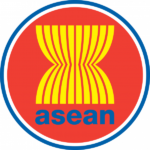
- The ASEAN Emblem represents a stable, peaceful, united and dynamic ASEAN.
- The blue represents peace and stability. Red depicts courage and dynamism, white shows purity and yellow symbolises prosperity.
- The stalks of padi in the centre of the Emblem represent the dream of ASEAN’s Founding Fathers for an ASEAN comprising all the countries in Southeast Asia, bound together in friendship and solidarity
- The circle represents the unity of ASEAN.
Institutional Machinery
As per Article-3 of the ASEAN Declaration, machinery to be established to fulfil the aims and the purpose of the association. In line with the same, basic institutional machinery comprises:
- ASEAN Summit: The member countries meet at the annual ASEAN summit to discuss the regional issues.
- ASEAN Secretariat: basic function is to coordinate among various organs of ASEAN and for more effective implementation of ASEAN projects and activities.
- ASEAN Coordinating Council (ACC): oversees the development and implementation of agreements. Various ASEAN bodies reports to ACC.
- Committees: various committees such as the Committee of Permanent Representatives to ASEAN, the ASEAN Connectivity Coordinating Committee (ACCC), the Initiative for ASEAN Integration (IAI) Task Force, etc are constituted to look after the assigned work.
ASEAN plus 3
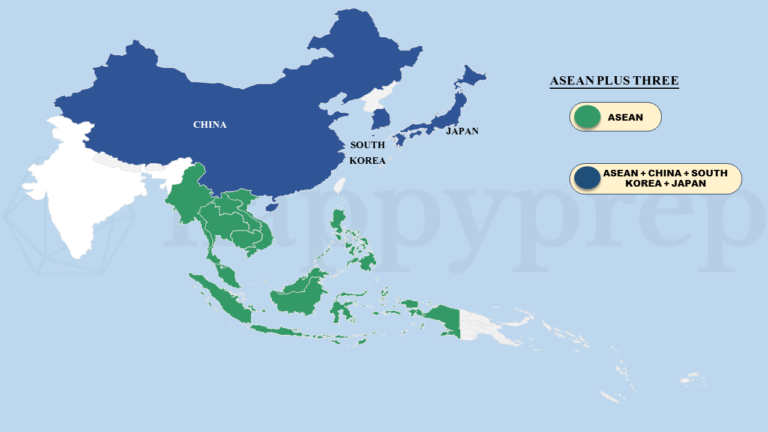
ASEAN Plus Three is a forum that functions as a coordinator of co-operation between the ASEAN and the three East Asian nations of China, South Korea, and Japan.
- It was created in 1997
- issues discussed include finance, food and energy security, disaster management, etc
ASEAN plus 6
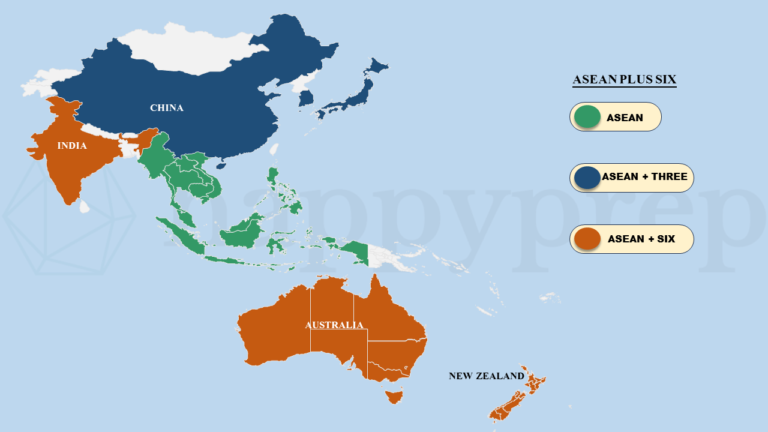
ASEAN plus 3 was first attempt to link South-East Asia with East Asia which further improved by the addition of India, Australia and New-Zealand. The grouping is termed as ASEAN plus 6.
Opportunities for India-ASEAN relationship
- India’s Act East Policy: With India’s Act East Policy, ASEAN can be an opportunity to establish a strategic connection within the region and help in promoting peace, security and handle cross border issues.
- Economic partnerships: ASEAN represents around 8.5% of world population and is a major trading partner of India.
- Maritime security: International trade and cargo in large volume goes through ASEAN water and securing these water along with ASEAN nations is another opportunity for India.
- Counter Chinese influence: Developing strong ties with ASEAN will only help India in challenging the growing influence of China in the region. The ties needs to be developed based on mutual trust and understanding.
- Development in North-East India: Connectivity with the ASEAN nations can act as the gateway of development for the North-Eastern states of India. These projects can increase the opportunities in the field of employment, trade and commerce, people to people contact, etc
- Tourism: Tourism is one of the sectors that is gaining traction among ASEAN nations and can be utilised to build soft power and goodwill among the nations.
Challenges in India-ASEAN relationship
- Non acceptance of RCEP: All the ASEAN and ASEAN plus 6 nations excluding India signed the Regional Comprehensive Economic Partnership (RCEP) in order to protect the domestic market
- Widening of trade deficit: Since the signing of RCEP in 2020, the trade deficit of India with ASEAN is only increasing creating a tremendous pressure on India to analyze the future actions.
- Increasing Chinese influence: China under its Belt and Road Initiative has expanded its reach into ASEAN region. It has also resulted into boundary disputes with ASEAN member nations such as Vietnam, Philippines.
- Infrastructure: Various infrastructural initiatives including Kaladan Multi-modal Transit Transport Project, India-Myanmar-Thailand Trilateral Highway Project, etc have seen significant delay affecting economic development and trade.
Regional Comprehensive Economic Partnership (RCEP)
- It is a free trade agreement(FTA)
- It makes the availability of goods and services of each country easier throughout the region.
- It has been signed by ASEAN nations and ASEAN plus 6 excluding India.
- India was at the forefront of the discussion but later refrained from joining the biggest trade bloc.
- The trade bloc accounts for about 30% of the world’s population and 30% of global GDP.
Why India didn't join RCEP?
Though many economists consider the withdrawal from the RCEP as a negative move however there are certain pressing reasons due to which India did not join RCEP.
- China factor: India currently has a trade deficit with China in the absence of FTA. After signing RCEP, the trade deficit could widen and can open the backdoors of imports.
- Abolition of tariffs: abolishing tariffs poses a threat to the local manufacturers. Such moves affect the MSMEs, small manufacturers, etc.
- Affect on dairy sector: RCEP can also affect the dairy sector as Australia and New Zealand are major milk producing countries. Such move can affect the farmers.
Want to read some more articles?
-
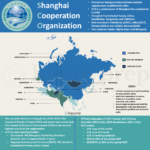 Shanghai Cooperation Organization (SCO): Origin, Members, Facts, etc for UPSC and other exams
Shanghai Cooperation Organization (SCO): Origin, Members, Facts, etc for UPSC and other exams -
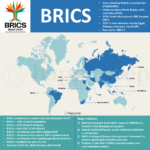 BRICS: Origin, members and others for UPSC, PSC & other exams
BRICS: Origin, members and others for UPSC, PSC & other exams -
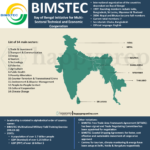 BIMSTEC for UPSC: Origin, Members & More
BIMSTEC for UPSC: Origin, Members & More -
 General Science for Competitive exams: UPSC, PSC, APFC, EO-AO, SSC, etc
General Science for Competitive exams: UPSC, PSC, APFC, EO-AO, SSC, etc -
 THE TRADE UNIONS ACT, 1926 for UPSC EPFO APFC/EO-AO, ALC, and Other exams
THE TRADE UNIONS ACT, 1926 for UPSC EPFO APFC/EO-AO, ALC, and Other exams -
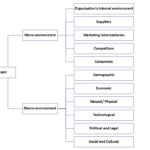 Understanding Macroenvironment: Marketing Environment in Principles of Marketing
Understanding Macroenvironment: Marketing Environment in Principles of Marketing -
 Understanding Microenvironment: Marketing Environment in Principles of Marketing
Understanding Microenvironment: Marketing Environment in Principles of Marketing -
Interjections in English
-
Conjunctions in English
Recruitment notifications update!
-
Recruitment 2025: Recruitment for Teaching Staff in The School of Planning and Architecture, New Delhi - Vacancy, Posts, Grade Pay, etc
-
Recruitment 2025: Vacancies in Inter-University Centre for Astronomy and Astrophysics (IUCAA)
-
Recruitment 2025: Recruitment on Deputation basis in National Anti Doping Agency (NADA)
-
Recruitment 2025: Various vacancies in Artificial Limbs Manufacturing Corporation of India (ALIMCO)
-
Recruitment 2025: Various vacancies in Land Ports Authority of India
Copyright© 2024 | All rights reserved | Made in India